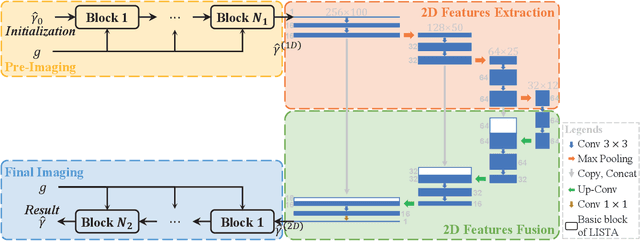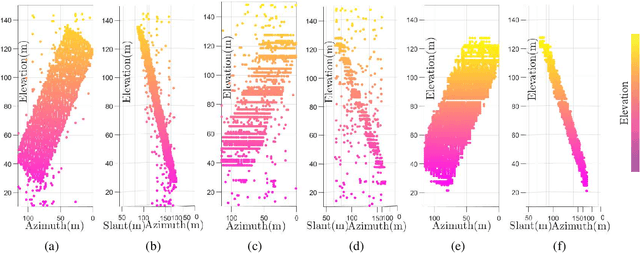Yunqiao Hu
Technical Report: Towards Spatial Feature Regularization in Deep-Learning-Based Array-SAR Reconstruction
Dec 22, 2024Abstract:Array synthetic aperture radar (Array-SAR), also known as tomographic SAR (TomoSAR), has demonstrated significant potential for high-quality 3D mapping, particularly in urban areas.While deep learning (DL) methods have recently shown strengths in reconstruction, most studies rely on pixel-by-pixel reconstruction, neglecting spatial features like building structures, leading to artifacts such as holes and fragmented edges. Spatial feature regularization, effective in traditional methods, remains underexplored in DL-based approaches. Our study integrates spatial feature regularization into DL-based Array-SAR reconstruction, addressing key questions: What spatial features are relevant in urban-area mapping? How can these features be effectively described, modeled, regularized, and incorporated into DL networks? The study comprises five phases: spatial feature description and modeling, regularization, feature-enhanced network design, evaluation, and discussions. Sharp edges and geometric shapes in urban scenes are analyzed as key features. An intra-slice and inter-slice strategy is proposed, using 2D slices as reconstruction units and fusing them into 3D scenes through parallel and serial fusion. Two computational frameworks-iterative reconstruction with enhancement and light reconstruction with enhancement-are designed, incorporating spatial feature modules into DL networks, leading to four specialized reconstruction networks. Using our urban building simulation dataset and two public datasets, six tests evaluate close-point resolution, structural integrity, and robustness in urban scenarios. Results show that spatial feature regularization significantly improves reconstruction accuracy, retrieves more complete building structures, and enhances robustness by reducing noise and outliers.
Enhancing Off-Grid One-Bit DOA Estimation with Learning-Based Sparse Bayesian Approach for Non-Uniform Sparse Array
Dec 14, 2024Abstract:This paper tackles the challenge of one-bit off-grid direction of arrival (DOA) estimation in a single snapshot scenario based on a learning-based Bayesian approach. Firstly, we formulate the off-grid DOA estimation model, utilizing the first-order off-grid approximation, incorporating one-bit data quantization. Subsequently, we address this problem using the Sparse Bayesian based framework and solve iteratively. However, traditional Sparse Bayesian methods often face challenges such as high computational complexity and the need for extensive hyperparameter tuning. To balance estimation accuracy and computational efficiency, we propose a novel Learning-based Sparse Bayesian framework, which leverages an unrolled neural network architecture. This framework autonomously learns hyperparameters through supervised learning, offering more accurate off-grid DOA estimates and improved computational efficiency compared to some state-of-the-art methods. Furthermore, the proposed approach is applicable to both uniform linear arrays and non-uniform sparse arrays. Simulation results validate the effectiveness of the proposed framework.
Collaborative Automotive Radar Sensing via Mixed-Precision Distributed Array Completion
Mar 13, 2024Abstract:This paper investigates the effects of coarse quantization with mixed precision on measurements obtained from sparse linear arrays, synthesized by a collaborative automotive radar sensing strategy. The mixed quantization precision significantly reduces the data amount that needs to be shared from radar nodes to the fusion center for coherent processing. We utilize the low-rank properties inherent in the constructed Hankel matrix of the mixed-precision array, to recover azimuth angles from quantized measurements. Our proposed approach addresses the challenge of mixed-quantized Hankel matrix completion, allowing for accurate estimation of the azimuth angles of interest. To evaluate the recovery performance of the proposed scheme, we establish a quasi-isometric embedding with a high probability for mixed-precision quantization. The effectiveness of our proposed scheme is demonstrated through numerical results, highlighting successful reconstruction.
Automotive Radar Sensing with Sparse Linear Arrays Using One-Bit Hankel Matrix Completion
Dec 09, 2023

Abstract:The design of sparse linear arrays has proven instrumental in the implementation of cost-effective and efficient automotive radar systems for high-resolution imaging. This paper investigates the impact of coarse quantization on measurements obtained from such arrays. To recover azimuth angles from quantized measurements, we leverage the low-rank properties of the constructed Hankel matrix. In particular, by addressing the one-bit Hankel matrix completion problem through a developed singular value thresholding algorithm, our proposed approach accurately estimates the azimuth angles of interest. We provide comprehensive insights into recovery performance and the required number of one-bit samples. The effectiveness of our proposed scheme is underscored by numerical results, demonstrating successful reconstruction using only one-bit data.
IHT-Inspired Neural Network for Single-Snapshot DOA Estimation with Sparse Linear Arrays
Sep 15, 2023Abstract:Single-snapshot direction-of-arrival (DOA) estimation using sparse linear arrays (SLAs) has gained significant attention in the field of automotive MIMO radars. This is due to the dynamic nature of automotive settings, where multiple snapshots aren't accessible, and the importance of minimizing hardware costs. Low-rank Hankel matrix completion has been proposed to interpolate the missing elements in SLAs. However, the solvers of matrix completion, such as iterative hard thresholding (IHT), heavily rely on expert knowledge of hyperparameter tuning and lack task-specificity. Besides, IHT involves truncated-singular value decomposition (t-SVD), which has high computational cost in each iteration. In this paper, we propose an IHT-inspired neural network for single-snapshot DOA estimation with SLAs, termed IHT-Net. We utilize a recurrent neural network structure to parameterize the IHT algorithm. Additionally, we integrate shallow-layer autoencoders to replace t-SVD, reducing computational overhead while generating a novel optimizer through supervised learning. IHT-Net maintains strong interpretability as its network layer operations align with the iterations of the IHT algorithm. The learned optimizer exhibits fast convergence and higher accuracy in the full array signal reconstruction followed by single-snapshot DOA estimation. Numerical results validate the effectiveness of the proposed method.
Widely Separated MIMO Radar Using Matrix Completion
Aug 29, 2023Abstract:We present a low-complexity widely separated multiple-input-multiple-output (WS-MIMO) radar that samples the signals at each of its multiple receivers at reduced rates. We process the low-rate samples of all transmit-receive chains at each receiver as data matrices. We demonstrate that each of these matrices is low rank as long as the target moves slowly within a coherent processing interval. We leverage matrix completion (MC) to recover the missing samples of each receiver signal matrix at the common fusion center. Subsequently, we estimate the targets' positions and Doppler velocities via the maximum likelihood method. Our MC-WS-MIMO approach recovers missing samples and thereafter target parameters at reduced rates without discretization. Our analysis using ambiguity functions shows that antenna geometry affects the performance of MC-WS-MIMO. Numerical experiments demonstrate reasonably accurate target localization at SNR of 20 dB and sampling rate reduction to 20%.
AETomo-Net: A Novel Deep Learning Network for Tomographic SAR Imaging Based on Multi-dimensional Features
Sep 21, 2022


Abstract:Tomographic synthetic aperture radar (TomoSAR) imaging algorithms based on deep learning can effectively reduce computational costs. The idea of existing researches is to reconstruct the elevation for each range-azimuth cell in one-dimensional using a deep-unfolding network. However, since these methods are commonly sensitive to signal sparsity level, it usually leads to some drawbacks like continuous surface fractures, too many outliers, \textit{et al}. To address them, in this paper, a novel imaging network (AETomo-Net) based on multi-dimensional features is proposed. By adding a U-Net-like structure, AETomo-Net performs reconstruction by each azimuth-elevation slice and adds 2D features extraction and fusion capabilities to the original deep unrolling network. In this way, each azimuth-elevation slice can be reconstructed with richer features and the quality of the imaging results will be improved. Experiments show that the proposed method can effectively solve the above defects while ensuring imaging accuracy and computation speed compared with the traditional ISTA-based method and CV-LISTA.
 Add to Chrome
Add to Chrome Add to Firefox
Add to Firefox Add to Edge
Add to Edge